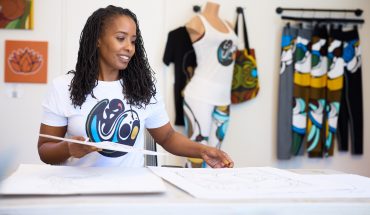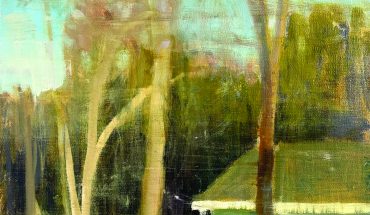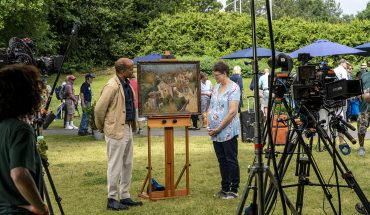For this multimedia maker, art is life and life is art.
Written by Charles Upchurch | Photographs by Jillian Clark
When it’s time to make the movie, Hollywood will go gaga for Louis St.Lewis. There’s the strict Southern upbringing, with a cast of characters worthy of Tennessee Williams. There’s the escape of a gifted but tortured young artist from his close-knit hometown, the ascent into the glamorous orbit of Warhol in 1980s Manhattan, and the final triumph of critical acclaim as a transcendent talent.
In his work, as in his personal style and showmanship, St.Lewis embraces Romanticism over Realism, and embodies the contention of Oscar Wilde that “the highest art (and, perhaps, good champagne) rejects the burden of the human spirit.” In art, he found refuge, purpose and persona. St.Lewis is creativity in the flesh, master of his aesthetic, and a splendid piece of work.
He’s also one of the most prolific artists in North Carolina. A 30-year resident of Chapel Hill, St.Lewis has been crowned “Best Artist in the Triangle” on 20 separate occasions. His mixed-media pieces, typically incorporating xerographic imagery, 3-D objects and illustration, are exhibited in the permanent collections of UNC’s Ackland Art Museum, the Wellington Gray Gallery at ECU, the Danville (Va.) Museum of Fine Arts & History, the Morris Museum, the Ogden Museum of Southern Art and the New Orleans Museum of Art.
St.Lewis has been hailed as a master of assemblage by the national journals Art News and Art Forum. Combining classical images of portraiture and figurative art with ornamental objects, decorative embellishments and his own pop-infused brushwork with paint and other media, the effect is a post-modern synthesis of surrealist formality, seductive rebellion, devilish humor and an all-consuming love affair with beauty.
“I’ve always admired artists of the past like Bronzino and Winterhalter, very arch stylists, but being a child of the 60s, I was swept away by the sheer audacity of pop art,” says St.Lewis.
It was audacity, after all, that led the aspiring artist from Raleigh to Warhol’s inner circle.
At the risk of ignoring Wilde’s warning about the “worship of facts,” here are a few: Louis Lewis, named for his great-grandfather (first name in the French, loo-ee), grew up in Wadesboro, North Carolina, in a family proud of its lineage connecting them to the explorer Merriweather Lewis, a second cousin to George Washington. The artist’s father, Frank Washington Lewis, a grocery merchant, was diagnosed in his teens with paranoid schizophrenia and intermittently visited Dorothea Dix Hospital in Raleigh for treatment. It was there he met his wife, Ruth. “He was leaving as my mother was going in,” St.Lewis says. His memories of his parents, both deceased, portray a web of psychological extremes that would spontaneously combust on the pages of a screenplay.
That’s another story entirely. You know—the movie.
Meanwhile, in high school he was a creative force of nature, painting, drawing, collage-making, designing every dance and prom and subsequently making unceremonious exits from a string of secondary schools before appropriating the family vehicle and disappearing to San Francisco. *insert family drama here.* Upon his return, he walked into the North Carolina School of the Arts in Winston-Salem. He was asked for his portfolio. This is it, he said, gesturing to himself. They enrolled him on the spot.
It lasted three semesters. He memorialized his departure with a costumed affair in the dormitory, replete with pomp and pageantry. In other words, with art. St.Lewis was—and is—a naturally occurring source of audacious originality.
On a visit to the emerging New York art scene in the mid-80s, where the lines between character, creativity and celebrity blurred, he found kindred spirits. In 1986, he wrote from Raleigh to the artists David McDermott and Peter McGough, known for living in the manner and dress of the 1880s, expressing admiration and offering to host them if they ever ventured south. They did (by train), and the friendship led to an invitation weeks later to join them in Manhattan for McDermott’s birthday party at the loft of painter Julian Schnabel. Andy Warhol would be there.
“Warhol photographed me the first time we met,” St.Lewis says (the negatives can still be found at Stanford’s Cantor Arts Center). “He was lovely to talk to. We spent time at the Palladium nightclub that week, corresponded for a while, and a year later he was gone.” The pop art icon had been impressed, dubbing the young North Carolinian’s creative output as, “Hieronymus Bosch meets MTV.”
Back home, the budding career of artist Louis St.Lewis would soon be in full flower.
“I self-beatified in 1982,” he says. “I decided I had suffered enough in childhood and schooling, so I might as well grab the title. And I have performed a miracle as required of any saint: I’ve made a living with art.”
It has been more than a living. It has been life, only larger. In addition to museum exhibitions, St.Lewis has made work for art expos, opera societies, ballet companies, charity galas, corporate clients, galleries and private collectors. He is known for his work as a writer and critic for publications in Raleigh, Durham and Chapel Hill over the past three decades, and has been a vocal advocate for artists and the Triangle arts community. But it is his newest partnership that finally puts St.Lewis closer than ever before to rock star status.
St.Lewis has joined forces with the preeminent neon fabricator and glass artist Nate Sheaffer as creative collaborator at Glas, their sprawling studio, workshop and gallery on E. Whitaker Mill Road. Sheaffer, St.Lewis and team, including neon glass artisans Danielle James, Zach Willis and Sarah Clover, have reinvented the retro art of gas tube illumination, celebrating traditional and neo-vintage styles while putting a whole new “pop” into pop art.
By taking a St.Lewis eglomise panel—a handcrafted mirror backing created by layering metallic powders and resins—and deftly installing a neon accent to glow up a Renaissance, Victorian or punk rock image, art and energy are coupled to dazzling effect.
And now, the entertainment giant Live Nation has gotten in on the act. St.Lewis and Sheaffer are being shuttled across the country to liven up some of the top live music halls in America, from the main stage and bar to the VIP rooms. At the Ritz in Raleigh, Louisville’s Mercury Ballroom, Buckhead Theater in Atlanta, and the Fillmore venues in Charlotte, New Orleans and Philadelphia, there’s a whole new visual vibe—the signature cool of St.Lewis and company.
Here in town, look for their pieces at Vidrio, Trophy Brewing, Mulino, Gonza and Hummingbird. Last spring, the official image celebrating Artsplosure’s 40th Anniversary in Raleigh was none other than a Sheaffer-St.Lewis mash-up featuring the visage of Sir Walter Raleigh himself. The original version,
A Gathering of Monarchs, appeared in the September 2019 issue of Traditional Home magazine.
In the Atlanta-based magazine Art Papers, the writer Anne Heller described St.Lewis as “one of the most talented artists to arise from that moss-covered Gothic chrysalis called the South.” That’s what the movie will be about. A metamorphosis, releasing something beautiful. All good stories start with character.
With Louis St.Lewis, there is no higher art.
St.Lewis and Sheaffer created the cover art inspired by our namesake—including WALTER’s signature feather—specifically for our January/February 2020 issue. He’ll be selling Sir Walter of the Enlightenment (36”x36”) to fund another, larger piece that’s in the works. Sign up for our newsletter to be notified when the auction goes live.







